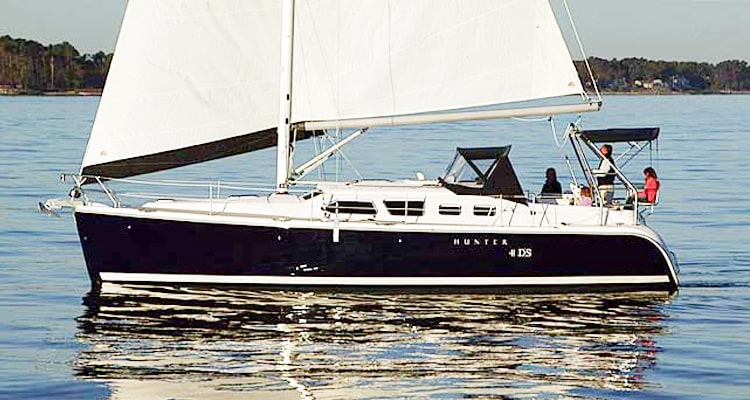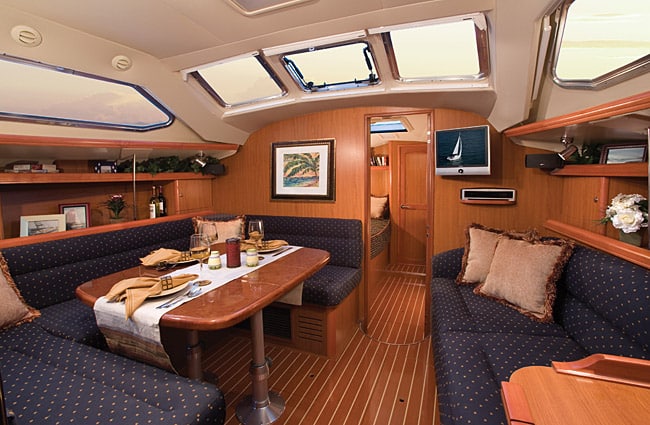
What luck! This blustery fall day on Chesapeake Bay, yacht designer (and Hunter’s director of engineering) Glenn Henderson would sail with us aboard one of his team’s creations, the shoal-draft version of the Hunter 41 DS, a spin-off from the year-old aft-cockpit Hunter 41. We joined the deck-saloon sloop by launch as it luffed up in Eastport’s lee, near the mouth of Back Creek in Annapolis, Maryland. People and gear were quickly pulled aboard, and Henderson was champing at the bit to tell me his baby’s story. “First off,” he said, “I wanted a boat that would have all the systems and conveniences you’d expect in a house and also be capable of long-distance offshore passages.”
I looked down the broad decks–the 41 DS has a 3:1 length-to-beam ratio–held high above the water by substantial freeboard, and I thought that the first part of the wish was eminently possible. But I also wondered, would she sail? So many builders of successful designs have pushed the interior-volume envelope so far that their creations no longer effectively harness the wind.
We cracked off in very light air, heading for the unprotected waters of the bay. I was visibly surprised when the boat-with a modest 17.2 sail area-to-displacement ratio–responded dramatically, accelerating as the optional Selden in-mast furling main and Furlex roller-furling genoa filled. Henderson had been watching for my reaction, and when he got what he wanted, he said, “Sail area/displacement doesn’t always tell the story. Right off the bat, I try to make my hulls easily driven. Of course,” he added with a wry smile, “they put three-bladed props on them, but I can’t do anything about that.”
Coaxing the Coefficients
Henderson then explained that with each boat he designs, he tries to push one of the design coefficients: fineness, block (underwater volume compared with a block with the same overall dimensions), midship (the ratio of underwater fullness to that same block amidships), or prismatic coefficient (Cp). For the Hunter 41 and 41 DS, he decided to push the Cp, a mathematical description of how full a boat is in the ends.
“The extremes for sailboats are between .49 and .62,” Henderson said, the higher figure equating to fuller ends. The higher the Cp, the more stable–and sluggish–the hull form. While trying to pick the ideal Cp at one point on the hull and determine an optimal speed-to-length ratio, it occurred to Henderson that the Cp is a single number that defines two different ends but treats them equally. “So I decided to cut the boat in two at max beam and make a graph of stern and bow Cps,” he said. Henderson analyzed the numbers from past Hunters, then extrapolated the ranges to the behavior of the respective designs. “I then could safely take that data and apply more radical treatment [to the 41 DS] and yet be safe that the boat wouldn’t be over the edge,” he said. The numbers he arrived at–lower Cp for the bow, higher for the stern–had the most effect on boat speed and motion.
The boat accelerated well in both light and heavy air, and it got up to speed quickly as we cleared Horn Point and took head-on the full 18- to 20-knot brunt of a northeasterly wind. While the seas weren’t large, they were sloppy and persistent, and the 41 DS coursed easily through them at more than 6 knots, the helm delicate and responsive as we picked our way through wakes and around crab-pot buoys. A stem closer to plumb not only increased the waterline but also reduced pitching.
For Henderson, responsiveness in the 41 DS was an important factor. It’s a “largish” boat, he said, and it’s likely to be carrying a number of passengers, with only one or two familiar with the boat. He wanted to make this boat as maneuverable as possible in crowded situations-wharf areas, marinas, crowded harbors, any tight quarters. The Whitlock direct-drive steering system and balanced spade rudder with a stainless-steel rudderstock certainly help to achieve this. “Responsiveness is also a good attribute when sailing in really rough seas offshore and steering through waves,” he added.
Versatile Deck Layout
Out in the bay, the 41 DS was steady and smooth as we put it through its paces. I’m 5 feet 7 inches tall, and I found the visibility forward, over the dodger, excellent. Where once the mainsheet was led solely to the cabin top, strategic positioning of hardware and winches allows the solo crew to trim from the companionway–or the gregarious skipper with a cockpit full of guests to run the boat from the fantail. The mainsheet can be led from the cabin top and sheeted on the spinnaker winch, creating little interference with the cockpit. When in port, the 40-inch wheel folds out of the way to create more space for socializing.
The side decks are wide and graced with a terrific nonskid pattern. The first time I went to the foredeck, I felt secure, bracing myself on the stout handrails on the dodger and the cabin top. Slippery areas existed, though, around the forward hatch and on the corners and visor of the house.
With 777 square feet of working sail (we sailed with the optional vertical-batten in-mast furling main) on a 19,400-pound displacement, this Hunter isn’t overcanvased. Yet in 13 to 15 knots of wind on a truly messy sea, we logged close to 7 knots of speed, accelerating with every gust but never overpowered. “I’d rather have a boat that’s easily driven and, at the same time, manageable and able to sail in relatively stiff breezes without reefing than one that excels in light airs to the exclusion of high-wind performance,” said Henderson.
The most impressive aspect of the 41 DS was how quickly it was able to accelerate. Henderson said he achieved this by pushing the volume forward so the stern corner was out of the water, which flattened the stern wave. “Hull speed is derived from bow and stern waves,” he said. “If the boat goes too fast and gets too far ahead of the stern wave, it falls into a hole. So, by virtue of an S-shaped curve at the quarters, I artificially induced a wave to form farther aft, which in essence increased the waterline length and the boat speed.”
When I went below on the wide companionway steps, holding on to perfectly positioned grabrails, the ride was smooth and quiet, even though conditions outside were anything but. Later, when we ran the 40-horsepower Yanmar with a conventional shaft at 2,500 rpm, the noise level remained low.

Light and Airy Saloon
Upon entering the saloon, I was struck by the awesome, 6-foot-10-inch headroom and the light and airiness created by the raised deck. Just forward and to port of the steps is the L-shaped galley. Corian countertops (with an inset waste bin and, to protect the dinette, a clear backsplash with rounded edges) are surrounded by high, inward-curved fiddles, which do double duty as grabrails as you prepare meals and approach or descend the companionway. These ergonomic fiddles are found throughout the boat along shelf edges over settees and in the cabins. In the galley, at the stove, a harness will be needed, especially when on port tack.
The double sinks, positioned diagonally in the angle of the L, would take some getting used to while washing up in a seaway. Aft of them is a gimbaled two-burner propane stove and oven, with a microwave set above, and a stainless-steel front-loading fridge. The pantry, with shelves and a deep bin, is worthy of any small home, and there’s in-sole storage for cans and jars. With two opening ports, a hatch, and proximity to the companionway, galley ventilation will be superb. Forward of the galley is the dinette; all three seats could serve as extra berths while on passage, and the table, with telescoping support, converts to a double berth. A vertical stainless-steel grabrail is conveniently located between the galley counter and the dinette.
The aft head/shower stall, with two frosted opening ports, is to starboard of the companionway; just aft of it is the door to the aft cabin, with its athwartships queen berth, private entrance to the head, Corian-topped vanity, cedar-lined hanging locker, and lots of drawers. With two opening ports and a hatch, cross-ventilation will be excellent. The forward-facing nav station, forward of the head, has a radiused, battened seat for comfort and efficiency in a seaway, a lift-top desk with more of those seamanlike fiddles, and a mahogany console on which to mount remote instrument readouts. Opposite the dinette is a full-sized couch, with a large drawer under and, on the boat we sailed, a plasma-TV and sound system over.
The forward cabin, with 6 feet 2 inches of headroom, has a comfy double to port, with fiddled shelves all around and drawers under. To starboard is another cedar hanging locker and a Corian-topped vanity. The head/shower is in the peak and, thus, only usable on a flat sea or in port.
I stepped off this Hunter impressed. The 41 DS seems to cover many bases and includes many details in an attractive package that really works. Apparently, Cruising World’s 2006 Boat of the Year judges also think the Hunter Design Group is on the right track: The 41 DS was voted Best Production Cruiser 40 to 44 Feet (see “Crunching the Numbers,” January 2006).
Also noted by the BOTY judges was Hunter’s attention, throughout the boat, to American Boat & Yacht Council (ABYC) specifications, anticipating, in at least two cases–carbon-monoxide and smoke detectors–future ABYC recommendations. One judge, ABYC curriculum designer and senior instructor Ed Sherman, said, “I think the build quality is much higher in terms of fit and finish. It certainly represents a lot of bang for the buck.”
But for me, it was the Hunter’s performance that stood out, which I reiterated to Henderson. “My primary objectives were high stability, boat speed, a good motion in a seaway, and reactivity or responsiveness,” he replied. “These four attributes make up what is commonly known as ‘performance.'”
Nim Marsh is a Cruising World contributing editor.
HUNTER 41 DECK SALOON
LOA 40′ 4″ (12.29 m.)
LWL 35′ 6″ (10.82 m.)
Beam 13′ 3″ (4.04 m.)
Draft (shoal/deep) 5′ 0″ (1.52 m.)/6′ 6″ (1.98 m.)
Sail Area (100%) 928 sq. ft. (86.2 sq. m.)
Sail Area (furling) 777 sq. ft. (72.19 sq. m.)
Ballast(shoal/deep) 6,612/6,506 lb. (2,999/2,951 kg.)
Displacement (light ship) 19,400 lb. (8,800 kg.)
Ballast/D (shoal/deep) .34/.33
D/L 194
SA/D (furling) 17.2
Water 100 gal. (379 l.)
Fuel 36 gal. (136 l.)
Mast Height 60′ 2″/62′ 10″
(standard/furling) (18.34/19.15 m.)
Engine 40-hp. Yanmar
Designer Glenn Henderson
Base Price $201,290
Hunter Marine Corp.
(386) 462-3077
www.huntermarine.com
HUNTER RESPONDS
We trust that you, too, will be as impressed as Nim Marsh was, and we feel it appropriate that the Hunter 41 DS not only earned the 2006 Cruising World award for Best Production Cruiser 40 to 44 Feet but also earned the 2006 Cruising World Overall Best Value award.
John Peterson
Hunter Marine








